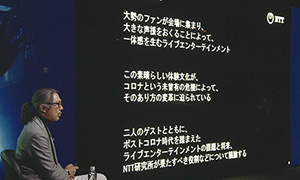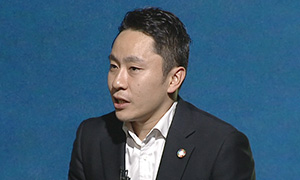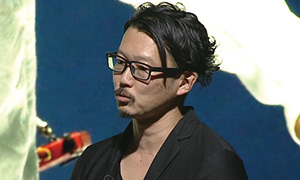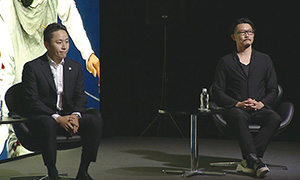 |
|||
|
|
|||
|
Feature Articles: NTT R&D Forum 2020 Connect Special Sessions Vol. 19, No. 3, pp. 13–15, Mar. 2021. https://doi.org/10.53829/ntr202103fa1  Sports & Live Entertainment Viewing Re-imagined in the Post-coronavirus EraAbstractOn November 19th, 2020, special session 1 of NTT R&D Forum 2020 Connect was held and live streamed. The session welcomed guests Yuki Ota, president of the Japan Fencing Federation and vice president of the International Fencing Federation and Haruyuki Moroishi, CEO and CCO of IMAGICA EEX Inc. and general producer of IMAGICA GROUP. The author, Shingo Kinoshita, executive research engineer, NTT Service Evolution Laboratories, moderated a discussion on the theme “Sports & Live Entertainment Viewing Re-imagined in the Post-corona Era.” During the session, they discussed the current status and future of sports and live entertainment during the novel coronavirus pandemic. Keywords: sports, live entertainment, experience-oriented 1. IntroductionAccording to the May 2020 announcement by the PIA Research Institute, the number of live events, including sports, concerts, and theater, canceled or postponed from February 2020 to the end of that year in Japan is estimated to be about 432,000, and the resulting financial loss due to those cancellations is estimated to be 77% of the market size, about 690 billion yen [1]. The amazing experience and culture of sports and live entertainment, through which a multitude of fans gather at a single venue and create a sense of unity by cheering loudly, is being forced to change due to the novel coronavirus pandemic. During special session 1 of NTT R&D Forum 2020 Connect, the participants discussed the challenges and future vision concerning sports and live entertainment in the post-coronavirus era as well as the role that NTT should play. 2. Initiatives by NTT toward the post-coronavirus eraAt the beginning, I explained what is happening in the sports- and live-entertainment industries. Many live-entertainment events have been canceled or postponed, and even when an event is held with no spectators or a reduced number of them, cheering loudly and high-fiving are prohibited. Under such circumstances, online live concerts were successfully held in Japan and abroad by applying creativity and technology. Initiatives were taken to enliven sports venues with no spectators by deploying “virtual fans” via computer graphics and electronic-conferencing systems, and bicycle racing went virtual by using a simulator. I also introduced a technology called “Kirari!” that NTT has been developing since before the pandemic, which delivers the entire competition space to remote venues in real time by transmission of ultra-realistic information. A demonstration of distributed ultra-realistic viewing, which creates a sense of unity by synchronizing the match venue and remote venues with ultra-low-latency communication technology, was showcased at the session.
3. Initiatives by the Japan Fencing FederationGuest Yuki Ota, president of the Japan Fencing Federation and vice president of the International Fencing Federation, introduced the efforts both fencing federations have made from before the pandemic to the present. The reform of fencing competitions, which has been ongoing since 2017, was described by Mr. Ota. He talked about how the number of spectators and the unit price of tickets have increased by creating posters to show the coolness of the fencers and changing the venue from conventional gymnasiums to theaters. He also reported on the remote-watching experience at a finals tournament held with the cooperation of NTT. The “Heartbeat Experience” is a system that allows families of fencers supporting from a separate venue to watch bouts while feeling the heartbeat of the fencers during the bout. Data from a heart-rate monitor worn by a fencer is transmitted to a ball-shaped device possessed by the fencer’s family, and the fencer’s heartbeat is experienced as “vibration and light.” “Remote High Five” is a solution that enables fencers at a tournament venue and their families cheering from another venue to celebrate with high fives. The vibration generated by a person touching a transparent board installed at each venue is measured and transmitted to a remote location together with videos. This solution enables two-way communication even when watching a bout from a remote location in a manner that communicates the excitement and joy of sports.
4. Initiatives by IMAGICA EEXThe other guest, Haruyuki Moroishi, CEO and CCO of IMAGICA EEX Inc. and general producer of IMAGICA GROUP, explained the transformation of the live-entertainment industry’s business model during the pandemic. The industry has been growing with the principle of “the supremacy of the real world,” but from the perspective of avoiding the “three-Cs” (closed spaces, crowded places, and close-contact settings) and maintaining social distance, this must be changed. He said it seems to being transforming from a “theater-oriented” business model based on earning ticket revenue in the physical space of theaters, etc. to an “experience-value-oriented” business model based on using distribution and live viewing services. As his latest initiative, he introduced “Tsuyoshi Nagabuchi Online Live ALLE JAPAN,” which he was in charge of planning and producing. It was a live performance, watched by more than 100,000 people, of 16 songs delivered online for two and a half hours. By installing three 300-inch light-emitting diode (LED) screens, a 360-degree immersive stage environment was created. On these LED screens, 300 remote audiences were shown, who sang together, which gave them a sense of unity and real-time experience. At a normal live venue, there is a spatial distance between the artist and fans due to physical constraints; however, through this new production and expression of communication that uses video and live streaming and application of new technology, the distance of mind between them could be reduced to zero. Mr. Moroishi said that he discovered the possibility of new live entertainment that fuses the real and virtual through this live event.
5. DiscussionWhile the effectiveness of online live events was being reaffirmed, I asked the guests during the final section of the session about the future of sports and live entertainment. In response, while predicting that future of such events will be a hybrid of online and real events, Mr. Ota expressed a sense of crisis that the oligopoly of a few major event production companies may strengthen as globalization progresses. Mr. Moroishi said that he is looking forward to the creation of new business and the expansion of the entertainment world resulting from the fusion of technology and creativity enabled by the spread of 5G (5th-generation mobile communication system), artificial intelligence, and other new technologies. The discussion was very meaningful and lively on the topic of future sports. Unfortunately, there was not enough time to continue the discussion.
Reference
|
|||












